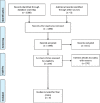The role of online social networking on deliberate self-harm and suicidality in adolescents: A systematized review of literature
- PMID: 30581202
- PMCID: PMC6278213
- DOI: 10.4103/psychiatry.IndianJPsychiatry_414_17
The role of online social networking on deliberate self-harm and suicidality in adolescents: A systematized review of literature
Abstract
Social media use by minors has significantly increased and has been linked to depression and suicidality. Simultaneously, age-adjusted suicide rates have steadily increased over the past decade in the United States with suicide being the second most common cause of death in youth. Hence, the increase in suicide rate parallels the simultaneous increase in social media use. In addition, the rate of nonsuicidal self-injury ranges between 14% and 21% among young people. Evidence suggests that self-harming youth is more active on online social networks than youth who do not engage in self-harm behavior. The role of online social networking on deliberates self-harm and suicidality in adolescents with a focus on negative influence was assessed by conducting a systematized literature review. A literature search on "PubMed" and "Ovid Medline" using a combination of MeSH terms yielded nine articles for data extraction satisfying predefined inclusion/exclusion criteria. It was found that social networking websites are utilized by suicidal and self-harming youth as a medium to communicate with and to seek social support from other users. Online social networking also leads to increased exposure to and engagement in self-harm behavior due to users receiving negative messages promoting self-harm, emulating self-injurious behavior of others, and adopting self-harm practices from shared videos. Greater time spent on social networking websites led to higher psychological distress, an unmet need for mental health support, poor self-rated mental health, and increased suicidal ideation. In conclusion, greater time spent on online social networking promotes self-harm behavior and suicidal ideation in vulnerable adolescents.
Keywords: Adolescent; online social networking; self-harm; social media; suicidality; youth.
Conflict of interest statement
There are no conflicts of interest.
Figures
Similar articles
-
Relationship of Social and Behavioral Characteristics to Suicidality in Community Adolescents With Self-Harm: Considering Contagion and Connection on Social Media.Front Psychol. 2021 Jul 13;12:691438. doi: 10.3389/fpsyg.2021.691438. eCollection 2021. Front Psychol. 2021. PMID: 34326799 Free PMC article.
-
Suicidal ideation and self-harm in lesbian, gay, bisexual, and transgender youth.Am J Prev Med. 2012 Mar;42(3):221-8. doi: 10.1016/j.amepre.2011.10.023. Am J Prev Med. 2012. PMID: 22341158
-
Self-harm behavior and suicidal ideation among high school students. Gender differences and relationship with coping strategies.Actas Esp Psiquiatr. 2011 Jul-Aug;39(4):226-35. Epub 2011 Jul 1. Actas Esp Psiquiatr. 2011. PMID: 21769746 English, Spanish.
-
A Systematic Review of Social Media Use to Discuss and View Deliberate Self-Harm Acts.PLoS One. 2016 May 18;11(5):e0155813. doi: 10.1371/journal.pone.0155813. eCollection 2016. PLoS One. 2016. PMID: 27191728 Free PMC article.
-
Assessing the impact of Instagram use and deliberate self-harm in adolescents: A scoping review.Int J Ment Health Nurs. 2023 Feb;32(1):14-29. doi: 10.1111/inm.13055. Epub 2022 Aug 22. Int J Ment Health Nurs. 2023. PMID: 35996859
Cited by
-
Chronicity of self-harming behaviors among adolescent teenage girls living in refugee settlements in Northern Uganda.BMC Psychol. 2024 Jul 16;12(1):394. doi: 10.1186/s40359-024-01897-1. BMC Psychol. 2024. PMID: 39014513 Free PMC article.
-
Use of digital media in suicide prevention in adolescents and young adults.Indian J Psychiatry. 2019 Jan-Feb;61(1):1-2. doi: 10.4103/psychiatry.IndianJPsychiatry_1_19. Indian J Psychiatry. 2019. PMID: 30745647 Free PMC article. No abstract available.
-
Dynamic reciprocal relationships between traditional media reports, social media postings, and youth suicide in Taiwan between 2012 and 2021.SSM Popul Health. 2023 Oct 22;24:101543. doi: 10.1016/j.ssmph.2023.101543. eCollection 2023 Dec. SSM Popul Health. 2023. PMID: 37965108 Free PMC article.
-
Social media use among adolescents with eating disorders: a double-edged sword.Front Psychiatry. 2024 Feb 9;15:1300182. doi: 10.3389/fpsyt.2024.1300182. eCollection 2024. Front Psychiatry. 2024. PMID: 38404474 Free PMC article.
-
The Association between Nonsuicidal Self-Injury and Perfectionism in Adolescence: The Role of Mental Disorders.Eur J Investig Health Psychol Educ. 2023 Oct 24;13(11):2299-2327. doi: 10.3390/ejihpe13110163. Eur J Investig Health Psychol Educ. 2023. PMID: 37998053 Free PMC article.
References
-
- Reid Chassiakos YL, Radesky J, Christakis D, Moreno MA, Cross C COUNCIL ON COMMUNICATIONS AND MEDIA. Children and adolescents and digital media. Pediatrics. 2016;138 pii: e20162593. - PubMed
-
- Lenhart A. Teens, Social Media & Technology Overview 2015. Washington, DC: Pew Internet and American Life Project; 2015.
-
- Felt LJ, Robb MB. San Francisco, CA: Common Sense Media; 2016. [Last accessed on 2016 May 16]. Technology Addiction: Concern, Controversy, and Finding a Balance. Available from: https://www.commonsensemedia.org/research/technology-addiction-concern-c... .
-
- Teen Fact Sheet. Pew Research Center Website. 2014. [Last accessed on 2017 Jul 13]. Available from: http://www.pewinternet.org/fact-sheets/teens-fact-sheet .
Publication types
LinkOut - more resources
Full Text Sources
Miscellaneous


